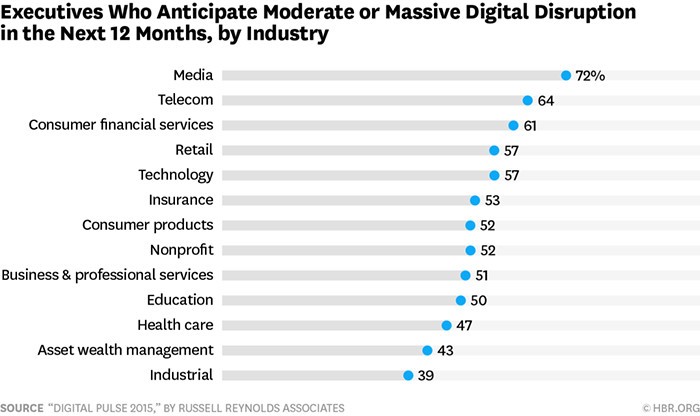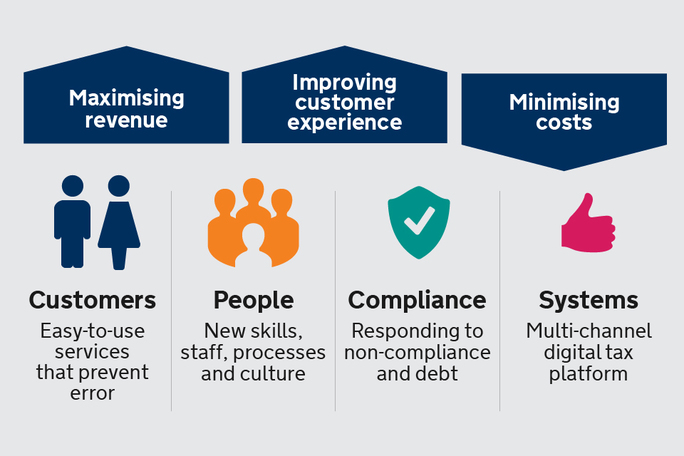infoTECH Feature
How to Make Digital Transformation Grow Your Business
What is it like to trim the sails to the winds of digital transformation today? Well, it is more than building a solid strategy with a carefully elaborated plan to go digital. On the contrary, a winning digital transformation strategy today is more liquid than ever.
At this very moment, if business wants to win the attention of more than 80 percent of perspective customers, or close to 95 percent if we are talking B2B, one needs to go digital. If you simply glance at the industries that, according to Russell Reynolds Associates, anticipate fundamental digital transformation, you may roughly estimate the scale of this “invasion.”

However, for most businesses a smart digital transformation strategy won’t just drip off their fingers. Times change, so as the nature of business environment. In terms of faster, more dramatic, and less predictable alterations across all business ecosystems, old digital strategies are claimed dead, while new versions are still on the way.
Let’s find out:
- How a smart digital transformation strategy once effective goes outdated.
- What a Digital Strategy 2.0 is.
- When a digital strategy unlocks growth for businesses and reinvents itself into a Business Growth Digital Strategy.
 The digital strategy as we know it
The digital strategy as we know it
Moving across the sketchy pictures of a digital strategy from over-formulated Wiki-like descriptions to more common yet one-legged definitions that touch upon only IT or social media, we came up with a more inclusive understanding of a classic digital strategy.
We see a classic digital strategy as the application of information and communication technologies that leads to adding value to people and businesses. In other words, it’s the blend of technologies into daily business activities that becomes the essence of a business strategy, rather than one of its parts.
A digital strategy is often confused with IT or marketing strategies. However, as a more complex and broad concept, a digital strategy would possibly digest both as inner elements and make them work as a tech and coordinative parts of its architecture.
To better understand why we dare to claim a digital strategy an inclusive idea that also forms a nucleus of a business strategy, you may simply look at successful digital strategy examples that illustrate how it works.
Consider a U.K. digital strategy by HM Revenue and Customs. Once established in 2014, it successfully accomplished 60 percent of its goals as of September 2016, and is to be fully discharged by 2018. Apart from clear objectives, such as maximizing revenue, minimizing costs, and improving customer experience, this strategy fully engages all elements of its transformation process through a “digital vision,” instead of simply embedding a couple of new apps into its operation.

Think of Oxford Dictionaries’ project that grounds its ambitious initiative to create living dictionaries for under-represented languages in its digital approach.
Or you can take this unsuccessful example that proves how make-up changes that might have looked like a digital strategy on the surface turn large investments into the ash on top of a once blossoming business.
Heard of Kodak (News - Alert)? These guys invested millions into their aggressive marketing campaign with a former Apple (News - Alert) consultant on the side and all bases covered. However, their campaign of building a “digital brand” has never turned into a digital strategy, since the way they worked remained “analog.” As a result, they ended up with major losses because their approach appeared outward and rootless.
Sad examples of kodaks and alike prove how simple it is to miss on the slippery road of quick-changing business environment. This is why, speculating about a digital transformation strategy in the end of 2016, we consider a classic version as solid state physics. Its basics always remain as laws, but the heavy hitters keep going quantum for more opportunities.
Digital Strategy 2.0
A digital strategist today is the one who knows the value of agility. This is why a rigid digital strategy is kicked off its pedestal by a more flexible concept, a Digital Strategy 2.0, which has different properties and objectives. This “liquid” digital strategy contributes to business growth anew, because business development itself no longer stands on solid pillars, but requires constant alignment.
- Future business growth is not associated with visible goals. Constantly altering environment dictates moving direction, but not the destination point.
- Risk control, insurance plans, and business security do not exist in a way that would let executives simply rely on well thought-out decisions. Nothing is steady, yet stability is seen in agility.
This is how the climate of business today makes a digital strategy transform. In fact, a mature strategy for digital transformation is no longer a concept, but a process focused on improving business, and not simply adding an app to its operations.
How a Digital Strategy 2.0 empowers business growth
- Formerly detached departments unite forces to increase performance, putting it to another level. Such transformations build new architecture. As a result, it makes the business bring more.
- For example, when staid IT department blends with chop and change marketing and they form a team, they get the results that none of them would have reached playing a lone hand. Think of PicCities project that managed to satisfy the ambitions of sales and marketing to increase customer engagement dramatically by installing an iOS application. Eventually, it brought the company the revenue that marketing activities alone might never get.
- When a new digital strategy starts shaping the activity within the business based on real-time decision-making, tighter connection within smaller but more effective teams, and better alignment to constantly changing business environment, all in all it allows cost-efficiency. In other words, it enables better results at lower costs.
- Do you know how much you need to develop a simple chatbot? It won’t cost you more than $10k-$15k to automate customer service and cover the needs of your business in B2C communication and social activity.
Business Growth Digital Strategy
Everything is related, and sometimes the question of origin turns into a true chicken-to-egg dilemma. We see how constantly reshaping business environment influences the way digital strategies form. At the same time, the contribution that a novel business strategy brings to a contemporary business scene is hard to underestimate. Often it’s a digital strategy that helps to build foundation for business growth opportunities. Therefore, business strategy today stems from a digital strategy.
Four wins of a Digital Strategy 2.0 that make business strategy work
- Time has more value. Instead of relying on long-term deep-rooted plans, businesses benefit from the digital transformation based on a new digital strategy. This strategy smoothly slides through a set of small time-sensitive activities. In the age of quick-changing conditions, time becomes too expensive to waste. With a business strategy based on a digital strategy at hand, companies can cut the losses caused by wasted time.
- Agility is more important than sustainable results. It’s not the one who gets steady outcomes who wins. It’s the one who knows how to reinvest these outcomes into more outcomes. Turning digital transformation into a process rather than a goal means bringing to businesses an asset of a greater value – agility.
- Businesses reach customers anew. User-friendly channels of communication, unrivalled user experience results, faster feedback, faster adaptation, faster everything, are the benefits that digitization brings to business. In fact, it’s not only business that alters under the influence of digital, it’s the whole market and communication models that get a push to a new level.
- Competition finally gets fair. Or close to fair. With digital at hand and in the core of every business, competition shifts into a completely new ecosystem. The roles of predator giants that manage big data and prey-like one-person companies neutralize. On the contrary, with a new digital strategy at hand competitors stand closer at the starting point degree mark and get more relevant business opportunities than ever.
In this regard, digital strategy consulting becomes an integral part of a new approach in building a strategy. Moreover, consulting becomes an organic part of a digital transformation strategy from the moment it is formed as an idea to the point when it brings tangible results and moves businesses to the new loops of growth.
On the one hand, a smart digital strategist is constantly combing the flow of novel technologies to pull out the ones matching the business strategy that the company has. On the other hand, consulting helps to shape a future digital strategy and impacts the business strategy of the company in tune with the trends of digital transformation in its field.
All in all, the shift from a digital strategy to the business growth digital strategy is visible. It has already started building major businesses’ strategies and influencing the way businesses make decisions and take actions. In this regard, the use of digital strategy consulting as professional support also transforms from bon ton to an essential tool for building a business growth digital strategy anew.
Edited by Alicia Young
infoTECH Headlines
What Is AWS EFS? Features, Use Cases, and Critical Best Practices
Cost-Effective Approaches to s1000d Conversion
A virtual crossroads for technology enthusiasts
Benefits of employee monitoring software in preventing overworking of workers
CI/CD: Trends and Predictions for 2024
Technical Documentation for IT: A Practical Guide
Managing Your Costs on AWS: A 2024 Guide
What Is Application Dependency Mapping?
Top 5 Kubernetes Errors and How to Solve Them
How Artificial Intelligence Can Improve the World of Online Gaming Platforms
Rich Tehrani
Rich Tehrani



 By
By 
